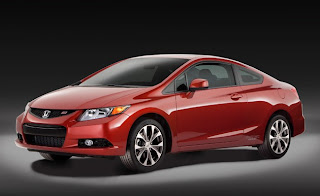 |
| 2012 Honda Civic |
Honda has always placed great emphasis on research and development, employing some of the best engineers in the automotive industry, which was evident way back in 1963, when it launched its first road car - the S500. With a high-revving twin-cam engine and chain-drive to the wheels, this was innovative stuff and a warning to other car makers of what was to come.
The 1970s: compound vortex controlled combustion (CVCC)
By the 1970s, America was waking up to the need to drastically improve the exhaust emissions from vehicles, and Honda wowed the car industry with an amazing new design. For the 1972 Civic, Honda stole a march on competitors by announcing their patented ‘CVCC’ combustion chamber - doing away with the need for a catalytic convertor while still passing tough Federal emissions laws.
The 1980s: variable valve time and electronic lift control
With strong roots in motorsport, Honda was never going to forget performance fans and 1988 saw the launch of‘Variable Valve Timing and Electronic Lift Control’ or VTEC as we all know it. A sophisticated system that allowed the engine to shift between two different camshaft profiles for maximum performance and driveability, VTEC introduced drivers to a whole new experience of sonorous, high-revving petrol engines. The technology reached its zenith in the awesome NSX which was just around the corner…
The 1990s: The NSX and EVs
The nineties was the decade that will always be remembered for the launch of the incredible NSX supercar. With a powerful VTEC engine, aluminium suspension and handling tuned by the late, great Ayrton Senna, the NSX redefined the supercar for a whole new generation. But it wasn’t all about performance. With stringent zero-emissions regulations looming in the US, Honda turned its engineering brains to the electric vehicle. Not only did it put an EV into production but it revolutionised battery technology along the way!
2000 and Beyond: designing for the future
Honda continued to bring us exciting concept cars, showcasing everything from advanced power trains and electronics to Space Age materials and construction. And while you can’t buy them, they certainly influence the cars you and I will buy in the future. And speaking of the future, step forward the Honda FCX Clarity, the world’s first commercially available fuel cell vehicle. Powered by hydrogen, the FCX is extremely efficient and its only tailpipe emission is water!
2010 and beyond: the Honda Civic
Continuing the trend for innovation and technology brings us to the new-for-2012 Civic. Petrol engines get the latest i-VTEC system, a redesigned cylinder head, and a host of lighter components while the diesel – a 2.2 litre i-DTEC unit – receives more extensive changes including new materials to make the engine stronger and lighter. A revised oil-flow system and redesigned internal components reduce internal friction, while a further boost to economy comes from a new ‘Idle Stop’ system on manual models. This shuts the engine down when the car is stationary – saving fuel when stuck in traffic – and restarts instantly when you are ready to go.
Aerodynamics too have come in for plenty of attention and the many hours spent in the wind tunnel have certainly paid off. Careful re-shaping of the rear spoiler and lights, and under-body panelling improves the flow of air, particularly at motorway speeds. A new grille shutter system for the diesels uses information such as air temperature, water temperature and speed, to optimise cooling and reduce drag.
ECO assist can improve economy by up to 15%, tells the driver when to change gear and even changes the colour of the speedometer from blue to green when you are being light-footed. Added to this is the ‘ECON’ button in the cabin which changes various settings, including throttle mapping and the air-conditioning system, to further maximise economy.
There is more technology inside with a new colour information screen for the driver. Called i-MID the screen displays a range of information including audio system and climate control settings and the status of the Idle Stop system. And on the safety front, the new ‘Collision Mitigation Braking System’ monitors the distance from the car in front and if a collision is imminent, provides assistance to the brakes and tightens the seatbelts to provide maximum protection for occupants.
The new Honda Civic 2012 is the culmination of over 40 years of automotive innovation from Honda. (adv)
A review of the 2012 Honda Civic from a consumers perspective. LotPro's Editor of Automotive Content, Steve Cypher test drives and reviews the new 2012 Honda Civic.







Honda cars are basically known for its fair performance and efficiency. Therefore around the world its market value frequently increases, here from this article, we came to know about the different models of Honda cars in different year or era. Thanks for highlighting such important topics.
ReplyDeleteEuropean Auto Maintenance Brooklyn, NY